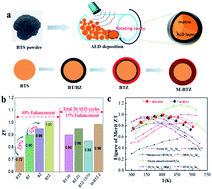Precision grain boundary engineering in commercial Bi2Te2.7Se0.3 thermoelectric materials towards high performance†
Abstract
The strong interrelation between electrical and thermo parameters has been regarded as one of the biggest bottlenecks to obtain high-performance thermoelectric materials. Therefore, to explore a general strategy to fully decouple thermoelectric parameters and synergistically optimize the thermoelectric performance is the ultimate goal of the research on thermoelectric materials. Herein, we present a grain boundary engineering approach based on the atomic layer deposition technology to enhance the performance of commercial Bi2Te2.7Se0.3 thermoelectric materials. Four groups of samples, including ZnO@BTS, TiO2@BTS, ZnO@TiO2@BTS, and multiple-(TiO2/ZnO)@BTS are prepared by precise controlling of the structure and composition of grain boundaries. Benefiting from the optimization of the microstructure and component of grain boundaries, the trade-off between the Seebeck coefficient, electrical conductivity and thermal conductivity is broken, resulting in a greatly enhanced thermoelectric performance. The maximum ZT value of 1.01 is achieved, which is 40% higher than that of a commercial Bi2Te2.7Se0.3 matrix. The study is promising in terms of the mass production of nanostructured thermoelectric materials with considerable improvements in performance via an industry compatible and reproducible route.



 Please wait while we load your content...
Please wait while we load your content...